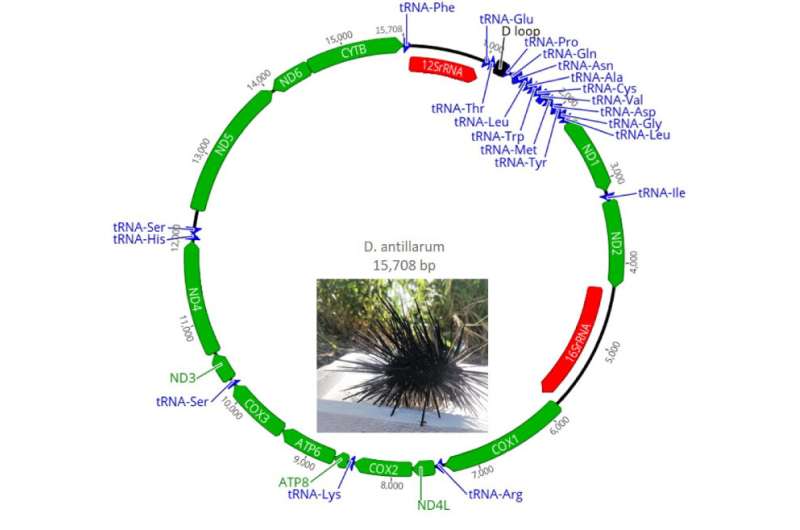Researchers publish mitochondrial genome of long-spined sea urchin, guardian of Caribbean coral reefs

A team of Oakland University researchers has published the first complete mitochondrial genome of Diadema antillarum, commonly known as the long-spined sea urchin. The invertebrate marine herbivore inhabits the shallow waters of the Western Atlantic and Caribbean and serves a crucial ecological function: grazing on algae along the region's coral reefs, preventing overgrowth that can threaten the reefs and the biodiversity they support.
About a quarter of the ocean's fish depend on coral reefs for habitat, which makes recurring die-offs of the long-spined sea urchin particularly troubling. The species has experienced die-off events during the 1980s and 1990s, as well as in the current year, with mortality rates reaching 90-95%.
"There are other species of sea urchin that inhabit and overlap with the niche of Diadema antillarum, but only this species suffered massive mortality events. No other closely inhabiting or cohabiting species died during these times," said Dr. Audrey J. Majeske, a special instructor in OU's Department of Biological Sciences and the study's lead author.
"This is a critical reason for collecting genetic information on this species—so we can design studies to understand why this species in particular continues to suffer from die-off events, and how to protect it from likely ongoing future events, especially if they are driven by human activity."
Coral reefs also provide numerous benefits to human communities, offering shoreline protection against hurricanes and drawing millions of tourists who use the reefs for recreation. According to The Nature Conservancy, coral reef-associated tourism in the Caribbean generates $8 billion annually.
Dr. Majeske conducted the study in collaboration with Stephanie O. Castro Márquez and Walter Wolfsberger, doctoral students in OU's Department of Biological Sciences. OU Biology Professor Dr. Taras K. Oleksyk was principal investigator of the project, which began when he and Dr. Majeske were faculty at the University of Puerto Rico at Mayaguez. The study was published in GigaByte.
"In addition to the main English version, a second version in Spanish was published online to make these findings available to the Spanish-speaking audience on the island (Puerto Rico) where the sea urchin sample was collected," said Dr. Oleksyk. "A Ukrainian version of the paper was published as well, to demonstrate the journal's solidarity with Ukraine's struggle in the war."
When sequencing the genome of Diadema antillarum, researchers also discovered that another species of long-spined sea urchin, Diadema savignyi, was misidentified in scientific literature. Clearing up the mistaken identity will help researchers better understand and document the distribution of sea urchins around the world. There are about 950 known sea urchin species that inhabit a wide range of depth zones in all climates across the world's oceans.
"Sea urchins are very ancient animals. They have been around since the Ordovician period, some 450 million years ago, and survived many great extinctions," said Dr. Majeske. "Understanding their distribution not only brings context to recent history, it helps put earth's biodiversity into geological and evolutionary perspective."
In addition to her work on this study, Dr. Majeske uses sea urchin genomes as part of the hands-on instruction students receive in her courses. Students investigate 16 genes in the Pacific purple sea urchin (Strongylocentrotus purpuratus), comparing and contrasting their expression across different samples, to understand how gene expression levels may change over the life of the organism. Findings from this study will help design future research studies for students, as well as inform the work of professional researchers.
"Students get hands-on experience performing the steps of the scientific method, including data collection and analysis, hypotheses-testing and drawing conclusions. This approach enhances student learning because it drives critical thinking," said Dr. Majeske. "It leads the students to connect the dots and understand why they reached those conclusions. That's what drives research and creates new knowledge in any field of science."
More information: Audrey J. Majeske et al, The first complete mitochondrial genome of Diadema antillarum (Diadematoida, Diadematidae), Gigabyte (2022). DOI: 10.46471/gigabyte.73
Provided by Oakland University















